What Does The Lens On A Camera Do
F inding the right lens for your camera can vastly improve your images and overall production, but learning about video and photo camera lenses can be expensive and time-consuming. In this article, we explain photo and video camera lenses so that you tin non but understand how your lens and camera work together but also which lens, or set up of lenses, is the best option for you moving forward. This is Photographic camera Lenses Explained.
Watch: Ultimate Guide to Photographic camera Lenses
Subscribe for more filmmaking videos similar this.
Table of Contents
Photographic camera Lenses Explained: Beefcake & Mechanics
- Video Photographic camera Lens Nuts
- Focal Length
- Aperture
- Shutter Speed
- Depth of Field
- Aspect Ratio
- Video Photographic camera Lens Extras
- Lens Animate
- Lens Flaring
- Chromatic Aberration
- Light Bokeh
- Camera Lens Examination Videos
1
Video Camera Lens Basics
ESSENTIAL CAMERA LENS Cognition
Camera Lenses Explained
Photo and video camera lens nuts
Camera lenses and eyes in general take been improved upon long earlier the invention of the camera, because lenses were useful centuries before the Lumiere Brothers were fifty-fifty born.
Photographic camera LENS DEFINITION
What is a photographic camera lens?
A camera lens is an optical body that features a single lens or an associates of lenses that mounts to a camera torso. Some lenses and interchangeable, while others are congenital into the construction of the photographic camera torso. Modern lenses attempt to set up the angle of incidence and angle of refraction to equal values to subtract the amount of abnormality, and feature a focus element that allows the operator to dictate which portions of the paradigm are acceptably precipitous, and which portions are blurred.
How do camera lenses work?
- Aperture dictates the amount of light that passes through the lens.
- The lens focuses the lite onto the paradigm sensor (digital) or moving picture aeroplane (analog).
Earlier we go into the pros and cons of prime lenses, take a minute to download our FREE Ebook — Camera Lenses Explained Vol. 1 — where we cover everything you demand to know near the dissimilar types of camera lenses, their unique visual characteristics, and how to use them.
Free downloadable bonus
Complimentary Download
Camera Lenses Explained
Every type of camera lens has distinct qualities and visual characteristics that every prototype-maker should empathise. Download our FREE eastward-book to go far-depth explanations on prime vs. zoom lenses, anamorphic vs. spherical lenses, wide bending, standard, telephoto and even specialty lenses that all tell a slightly different story.
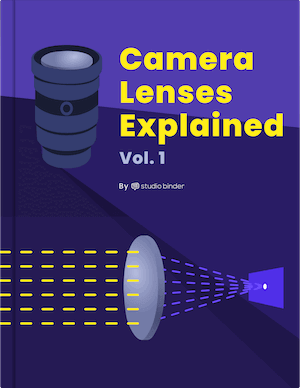
Knowing the photographic camera lens basics is more than just understanding the technicals. Each lens tells a slightly different story based on the "film language" adult over the last century of filmmaking.
For example, here'due south DP Roger Deakins discussing his personal thoughts on lens choice and the storytelling value of those decisions.
Roger Deakins & Lens Pick • Subscribe on YouTube
Camera Lens Explanation
Focal length nuts
What does "mm" mean on a lens?
Well, on the side and front of your photographic camera lens yous will find a small-scale "mm" with a number, or set of numbers next to it. This is a measurement (in millimeters) between the optical middle of the lens and the paradigm plane.
This measurement dictates the lens' focal length, or the surface area that lens is able to capture, as illustrated in the prototype below. The "longer" the focal length, the narrower the field of view and "shorter" focal lengths capture a wider prototype.
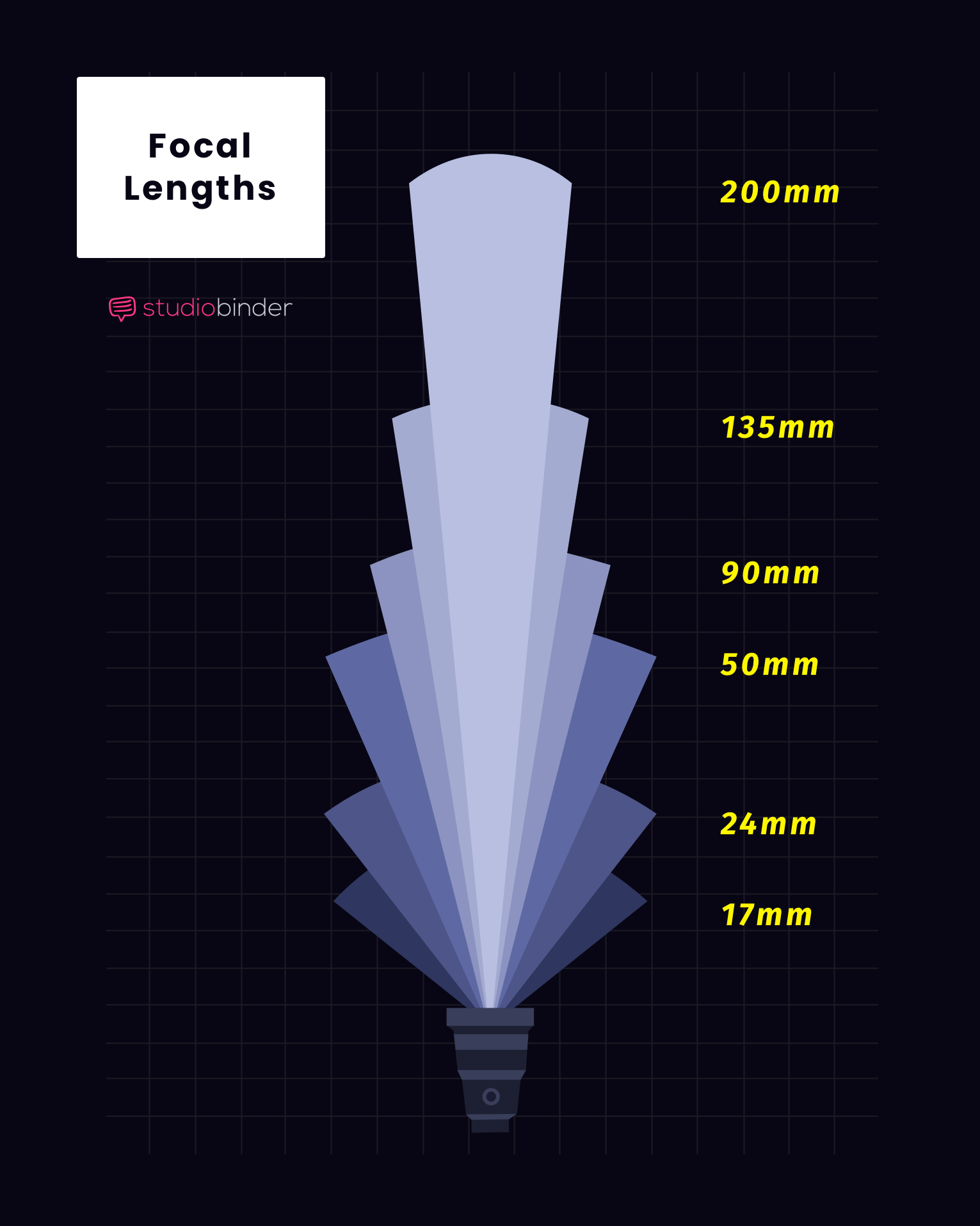
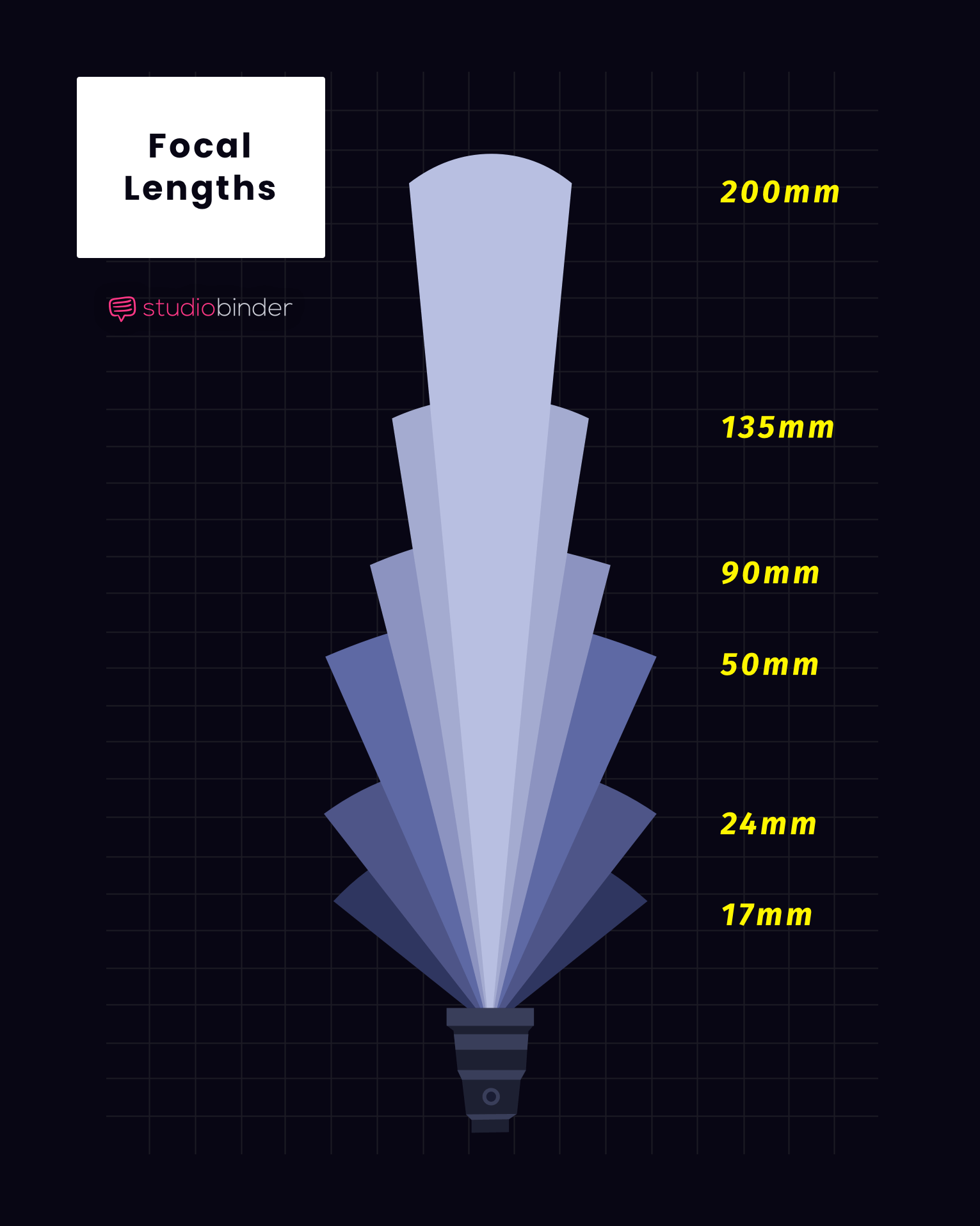
Camera lens mm - Focal Length
When information technology comes to photographic camera lenses, your focal length volition not only let you to capture footage with different visual properties, only those backdrop volition change the emotional effect the footage or image will have on the viewer.
There are both practical and creative reasons for choosing a specific photo or video photographic camera lens, so understanding focal length might exist the most important visual tool for a filmmaker or photographer to understand.
FOCAL LENGTH DEFINITION
What is focal length?
Focal length is the altitude between the optical center of the lens, and the photographic camera sensor or flick plane when focused at infinity. The optical center is where light rays converge inside the torso of your lens. The focal length defines the magnification and field of view for a given lens. This value is virtually commonly measured in millimeters. Prime lenses have set focal lengths whereas zoom lenses take variable focal lengths, and any change in magnification alters the visual properties.
Why is focal length important?
- Focal length dictates what part of the paradigm is in focus, isolating elements in either the foreground, middle ground or background
- It generates visual context for your shots
- And information technology alters the visual properties of your shots
A basic way of explaining focal length is the magnification of your lens.
A longer lens volition give yous a narrow paradigm that is closer to the subject, whereas a wider lens will capture more of the area from farther back.
Photographic camera Lenses Explained • Focal Length
Some high-contour performers even accept a "lens clause" congenital into their contracts that limit the focal length of any lens used to capture their image.
These performers sympathise the power of focal length.
They take a desire to retain some control over their professional images, and while this isn't an selection for a traditional player, certain musical artists and social media stars desire to keep their image consistent.
Some people may refer to the focal length at the lens size.
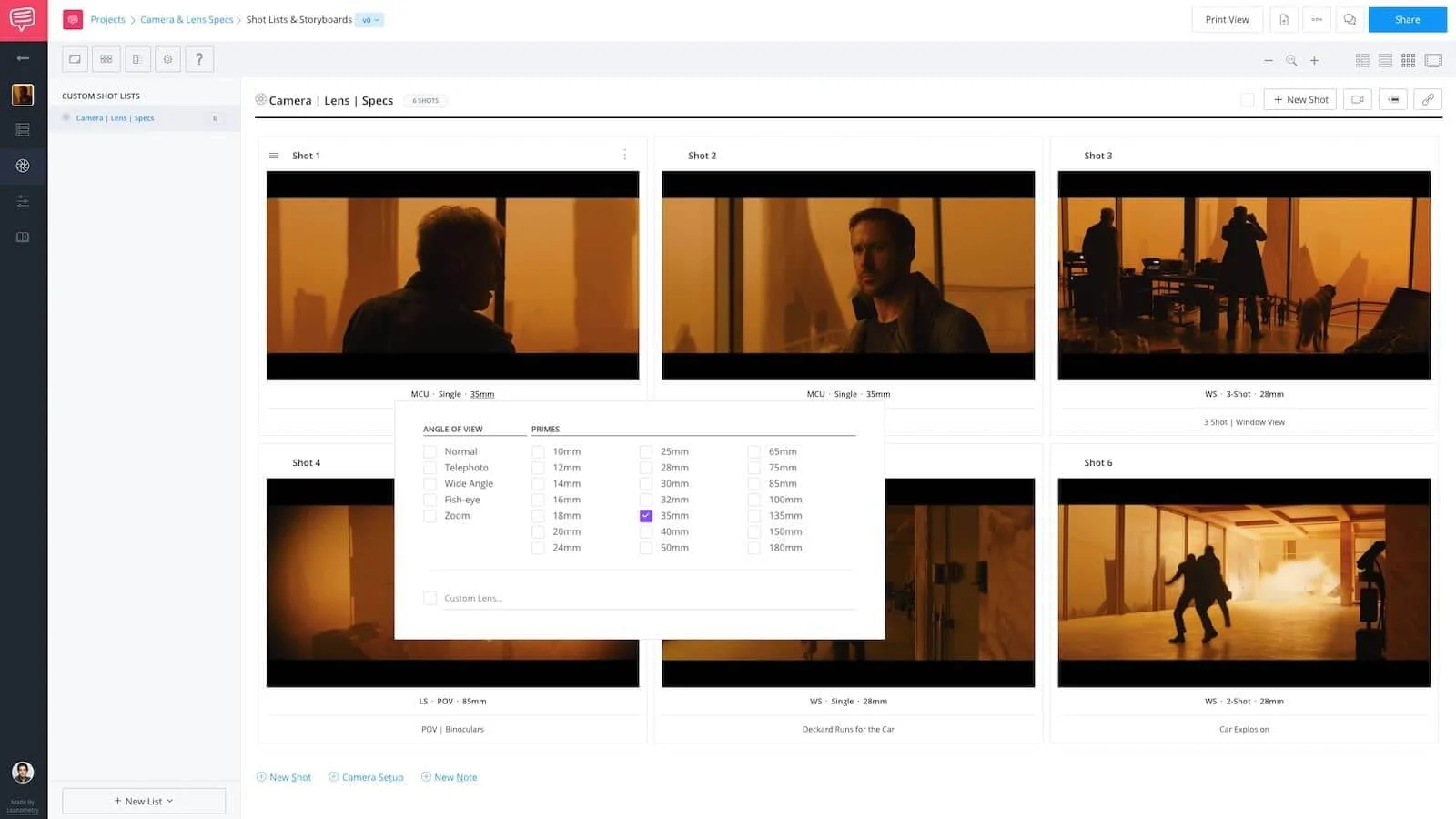
Shot list with lens size | StudioBinder
Any lens with a focal length 35mm to 55mm is categorized every bit "standard" focal length. This is considering the homo center has a like field of view.
At that place is vast discussion on this topic, and some fifty-fifty say a more authentic man focal length to exist closer to 22mm.
This is a relatively depression focal length for narrative filmmaking, but that doesn't mean you won't employ it, and some directors volition utilise it often.
Focal length matter both for photo lenses and video lenses because a photograph or a video recording that used a 50mm lens will take a drastically different look and experience to one that was captured with a 20mm.
Here is a scene from Blade Runner 2049 where the photographic camera is simulating a pair of binoculars, and to recreate the visuals you might get from optics like this example beneath, the filmmakers would employ a long angle lens, like an 85mm.
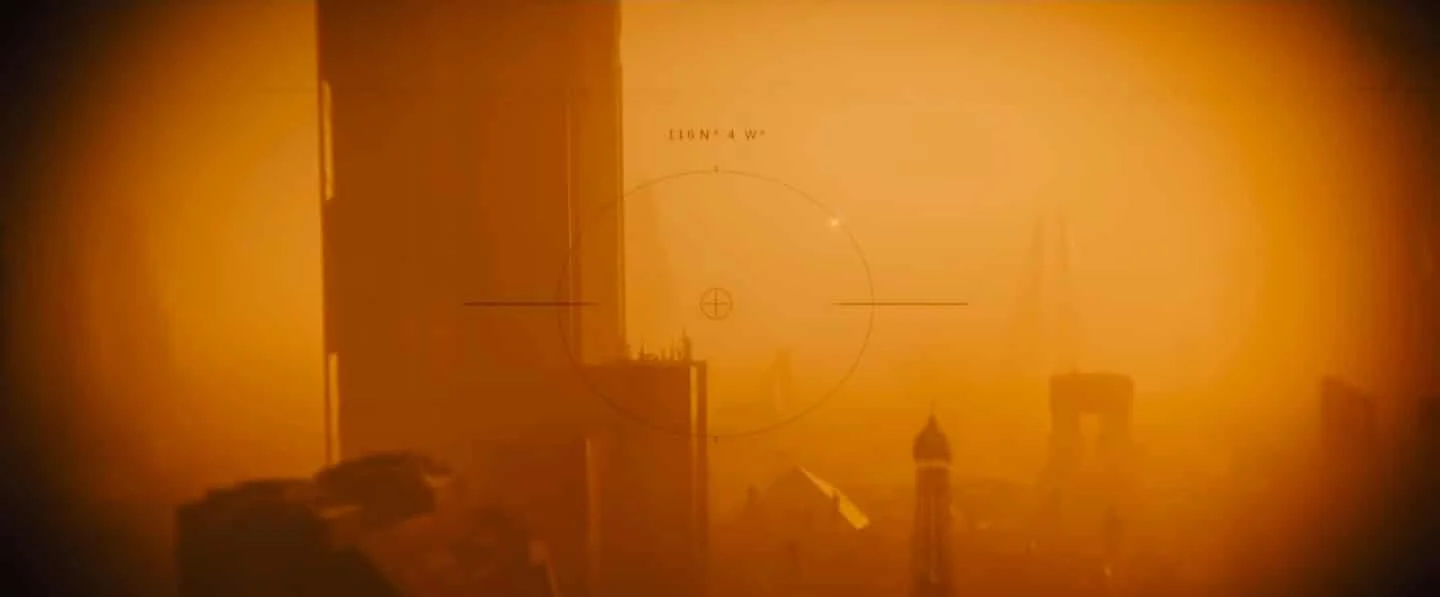
Long focal length used to simulate binoculars
This is one example of using a specific focal length of lenses for practical awarding in your story, but focal length tin likewise be used for emotional reasons.
Photographic camera Lens Terms Explained
What is a camera lens aperture?
Aperture describes the light intensity of a specific paradigm or set of images. Lens aperture controls light that passes through the lens to the paradigm sensor or film.
This is measured in:
F-Stops (Estimated Measurement) or T-Stops (Exact Measurement).
You will normally find T-Stops used when describing the best camera lenses versus a standard digital photography lenses.
Understanding Photographic camera Lenses Explained • What is Discontinuity?
T-Stop and F-Cease are not the aforementioned, though they are commonly mixed upwards or used in identify of i another.
Professional filmmakers bargain with T-Stops…
While many digital photography and indie filmmakers use the term F-Terminate, it really depends on the lens yous're working with. But know that they both refer to discontinuity stops.
The lower the stop number...
The higher the aperture (wider the opening).
That ways that a T2 is higher than a T8. That's considering the aperture is wider, and therefore lets in more than light.
Higher light intensity = Higher cease number
Camera lenses with higher stop ratings and wider openings allow more light, which means you can film in darker locations. Discontinuity range of a lens is expressed by the lens ratio (focal length divided past max aperture).
Understanding Cameras and Lenses
What is shutter speed?
Shutter speed is the corporeality of time the shutter is open. This is typically measured in fractions of a 2d, especially with video recording.
With still photography, shutter speed is much less rigid than with cinema & goggle box considering still photography is viewed as a unmarried frame.
But for video...
98% of the time y'all'll want your shutter speed to double your frame charge per unit.
What is Shutter Speed? • Subscribe on YouTube
Cinema Frame Rate
The standard frame charge per unit is 24fps (23.976fps), which ways your shutter speed should be set at 1/50. This means the sensor is exposed for 1/50th of a second. This 180 Degree Shutter Rule is meant to provide filmmakers with the expect and feel of what we're used to seeing over decades of filmmaking.
Television Frame Rate
The standard frame rate is 30fps (29.97fps), which means your shutter speed should be set at 1/60. This ways the sensor is exposed for ane/60th of a second.
You may notice that the math here is off a fleck, and there are some very complicated and logical reasons why these numbers have evolved over the years.
When would I use a non-standard shutter speed?
How about the Omaha Embankment scene in Saving Individual Ryan ?
Shutter Speed | Saving Private Ryan
In this scene, the crew actually replaced the shutter blades to shorten the corporeality of time the film was exposed.
This created a jagged look that actually works well for action.
Most probable you're non going to supercede the shutter on your camera. You tin achieve a similar wait past increasing shutter speed to 4x or 8x the frame rate.
Example: If you are shooting a film at 24fps, y'all might gear up your frame rate at 1/100 or one/200 to reach a choppy, staccato expect.
Math is your friend in film & television.
Camera Lenses Explained
What is depth of field?
Depth of field refers to how much of your image is in focus, and more specifically the area of acceptable focus.
A shallow depth of field volition give you a blurred groundwork, while a large depth of field will keep everything in focus so that we can see everything around us.
Ultimate Guide to Depth of Field • Subscribe on YouTube
With a shallow depth of field, your viewer (often) has less imagery to digest, and you tin can place more than emphasis on a specific part of your frame.
In this case below, you can see acceptably sharp imagery all around the frame, and even far off into the distance.
This shot has a large, long, or deep depth of field.
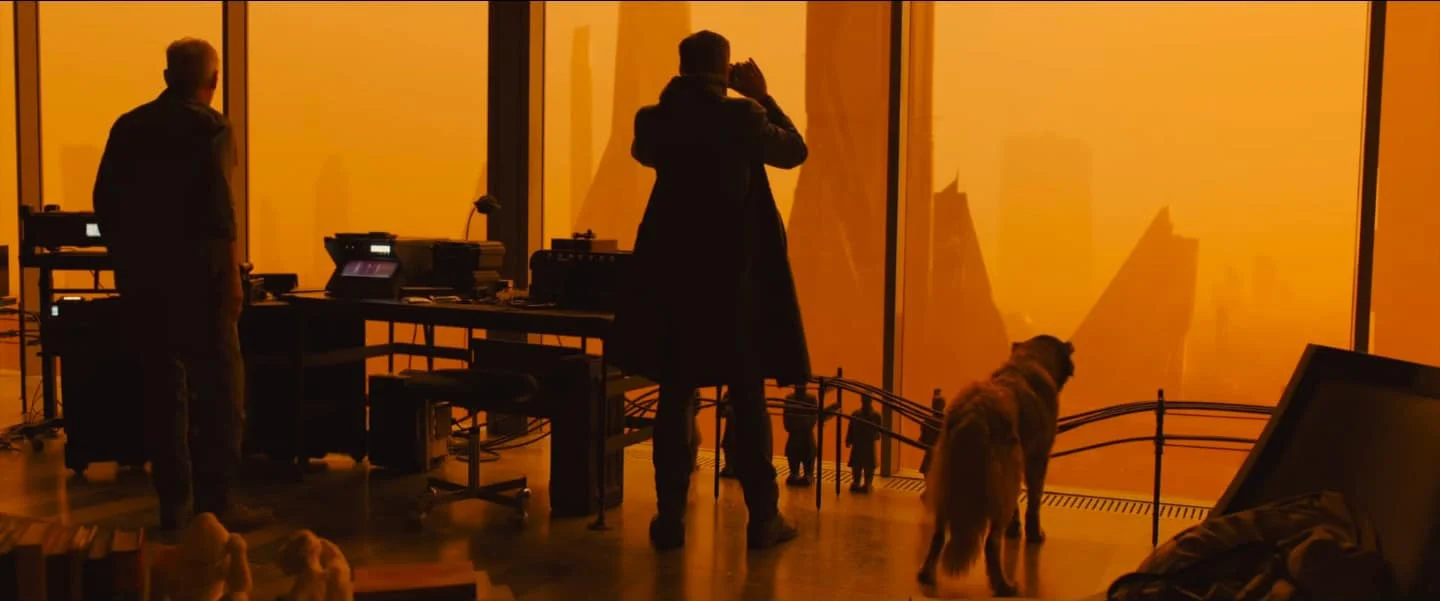
Camera lens specs from Bract Runner
Other times you want your entire scene in focus to allow your viewer to "drink it all in." It'south a toolbox. Different tools for different jobs.
Yous wouldn't employ a hacksaw to hammer in a spiral, would you?
VIDEO Photographic camera LENS Nuts
What is aspect ratio?
The aspect ratio of a lens is determined by the sensor size (or film size) of the camera with which it is intended to mountain. If a lens is built for an APS-C size sensor, it will non line up correctly with a full-frame photographic camera.
You may take the right mount, so the lens will physically attach to the camera, but it won't have the correct opening size, and thus creates a vignette where the low-cal is absent-minded.
Our video on aspect ratios shows yous how different ratios are used for presenting last cuts of projects, just your camera lens aspect ratio cannot be inverse, equally information technology is baked in the construction of the lens.
Attribute Ratios • Subscribe on YouTube
As you noticed from the video above, your bailiwick matter can help determine which aspect ratio is best for your project.
Consider this when selecting a camera lens.
VIDEO CAMERA LENS EXTRAS
What is lens animate?
Lens animate is the amount of shift in your bending of view when focusing. Most high-end lens manufacturers will eliminate breathing completely, just if y'all're looking to buy or rent a kit for your depression upkeep moving-picture show you'll desire a kit that has piffling breathing.
Lens animate
In still photography this isn't much of an upshot because an prototype is a single frame. Tin you lot imagine your frame limerick changing while pulling focus in a scene? Less than ideal.
Camera Lens Explanation
What is lens flaring?
Lens flaring is when low-cal is scattered in a lens organization, usually acquired past bright lights that smooth direct into the eye of the lens. This is more prominent in anamorphic lenses than spherical lenses simply it can exist accomplished with both types.
Photographic camera Lenses Explained • Lens Flares
Lens flares are often considered to be unwanted artifacts in your image. But they tin can also add together a visual texture to your imagery. If you lot know anything about J.J. Abrams' directing style, the kickoff affair that comes to mind is his utilize of lens flares.
Camera Lenses Explained
What is chromatic abnormality?
Chromatic aberration is your lens failing to focus all colors to the same convergence point. This normally presents itself equally "fringes" of color along boundaries that separate the light and dark parts of your image.
Chromatic Abnormality
This is ane of those really advanced lens specs that professional person cinematographers give attention.
Camera Optics Explained
What is bokeh?
Bokeh is a term used to describe when a lens renders out-of-focus points of light. It comes from the Japanese boke, and translates to "blur" or "haze." In that location are at least three types of bokeh you can achieve:
Camera Lens Bokeh
As you can encounter from the video above, different lens quality changes the type of bokeh y'all'll be able to achieve. Fifty-fifty your custom bokeh volition look a little dissimilar when using an anamorphic lens.
Photographic camera LENSES EXPLAINED
What is focus throw?
Focus throw is the physical rotation of the focus band from the MFD (Minimum Focus Distance) to 'infinity,' which is measured in degrees.
It's how much room you actually have to pull focus.
Cinema lenses have a dramatically higher throw than yet photograph lenses.
The throw is very of import in cinema and television because you need to make pinpoint adjustments when pulling focus from one discipline to another. The more degrees available, the more accurate your focus pull.
Cine lenses vs Photo lenses
Performing focus pulls with all the same photography lenses can besides shake the lens, resulting in footage that may be deemed unusable during the edit.
There are focus pull accessories for nonetheless photography lenses, merely the actual focus throw will probable remain the same.
Gratis downloadable bonus
Gratis Download
Camera Lenses Explained
Every type of photographic camera lens has distinct qualities and visual characteristics that every image-maker should understand. Download our Costless e-book to get in-depth explanations on prime number vs. zoom lenses, anamorphic vs. spherical lenses, wide bending, standard, telephoto and even specialty lenses that all tell a slightly different story.

UP NEXT
Types of camera lenses
So, what does the photographic camera lens do? Across focusing light to the focal plane, your camera lens creates the way your viewer watches your story. Information technology changes the way yous communicate with your audience.
All of the information you just read works for digital cameras and for film cameras, and that's the beauty of lenses. Beyond some lens quality and lens technology advancements, lenses take stayed the same for centuries.
We explain how each lens is categorized, the technology and scientific discipline behind it, and how they're used in filmmaking and photography.
Upwardly Next: Types of camera lenses →
Source: https://www.studiobinder.com/blog/understanding-camera-lenses-explained/
Posted by: stitesisfuld.blogspot.com

0 Response to "What Does The Lens On A Camera Do"
Post a Comment